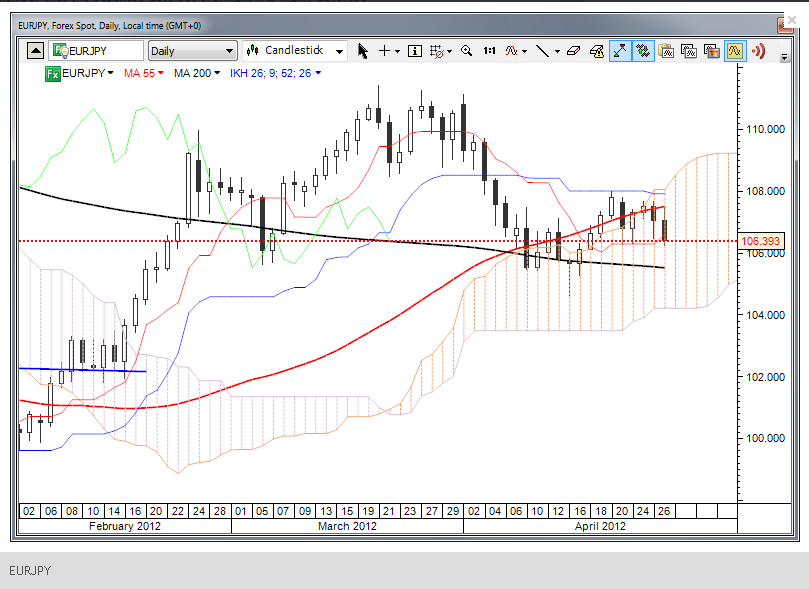The BoJ’s new measures saw a brief pop higher in JPY crosses overnight Thursday, but the JPY has pulled back to the strong side on another extension of the bond market rally and on the S&P downgrade of Spain.
Spain Drain On Risk Appetite
Yesterday’s New York equity session ended with a flourish and new recent highs, but not long after the close, S&P issued a two-notch downgrade to Spanish sovereign debt with a negative outlook and this rained on the risk appetite parade. EUR/USD pulled back from its double take at the 1.3250+ area and was back below resistance as of the early European trading hours. Spanish 10-year debt yields pushed back toward the critical 6.00% yield level in early trading today and US Treasurys and German bunds rushed higher, with the latter trading within a bp or so of its all-time low yield.. Just before we posted this, the Spanish official unemployment rate was released at 24.4%
BoJ Eases, But...
The BoJ announced a new expansion of its asset purchase programme of 10 trillion yen (to 40 trillion in all) and that purchases of longer dated debt will be added to the programme. But the immediate weakening of the yen in the wake of the initial headline that more QE is on the way quickly reversed course as the accompanying rise in inflation forecasts suggested that less QE may be in the pipeline than the market was assuming previously. Besides, as I said yesterday, the current market conditions are very supportive for the JPY, so the market was happy to seize on any excuse not to sell the JPY, particularly in the crosses.
EUR/JPY looks set for a renewed test of its 200-day moving average on the combination of the latest Spanish downgrade and safe-haven seeking in bond markets. Remember that the Japanese data out overnight on Thursday was highly distorted due to the earthquake/tsunami catastrophe from March of last year.
Chart: EUR/JPY
EUR/JPY reversed course on Thursday night and may be headed for another test of the 200-day moving average around 105.60. The sell-off deepens the technical commitment to staying in the daily Ichimoku cloud, the lower bound of which may be the short-term target if current risk off conditions persist.
Looking Ahead
The recent resistance in the US equity market (around 1392 on the cash S&P500) has been a key line in the sand for risk appetite and we have just seen an interesting test of that level with yesterday’s attempt higher rejected after the close. Unless we work back higher again and can overcome the latest bout of bad news, we’ve swung back into “risk-off” territory with this latest move. Still, it is interesting that the market brushed off the negative jobless report and negative Chicago Fed measures and instead seized on the positive US Pending Home Sales data for March as the news worth paying attention to. Adding to the drumbeat of more negative data that didn’t garner headlines yesterday, we also saw a weak KC Fed manufacturing survey and a sizable drop in the weekly Bloomberg Consumer Comfort survey.
Later on Friday, the focus shifted to the first estimate of Q1 US growth and the final reading for the April University of Michigan confidence.
Economic Data Highlights
- UK Apr. GfK Consumer Confidence out at -31 vs. -30 expected and -30 in Mar.
- Japan Apr. Markit/JMMA Manufacturing PMI out at 50.7 vs. 51.1 in Mar.
- Japan Mar. Jobless Rate out unchanged at 4.5% as expected
- Japan Mar. Overall Household Spending out at +3.4% YoY vs. +4.1% expected and +2.3% in Feb.
- Japan Mar. National CPI out at +0.5% YoY and -0.5% ex Fresh Food and Energy vs. +0.4%/-0.5% expected, respectively and vs. +0.3%/-0.6% in Feb.
- Japan Mar. Preliminary Industrial Production out at +1.0% MoM and +13.9% YoY vs. +2.3%/+15.6^ expected, respectively and vs. +1.5% YoY in Feb.
- Japan Mar. Retail Trade fell -1.2% MoM and rose +10.3% YoY vs. -0.5%/+10.0% expected, respectively and vs. +3.4% YoY in Feb.
- Germany May GfK Consumer Confidence out at 5.6 vs. 5.9 expected and 5.8 in Apr.
- Spain Q1 Unemployment Rate out at 24.44% vs. 23.8% expected and 22.85% in Q4
- Switzerland Apr. KOF Swiss Leading Indicator out at 0.40 vs. 0.2 expected and 0.09 in Mar.
